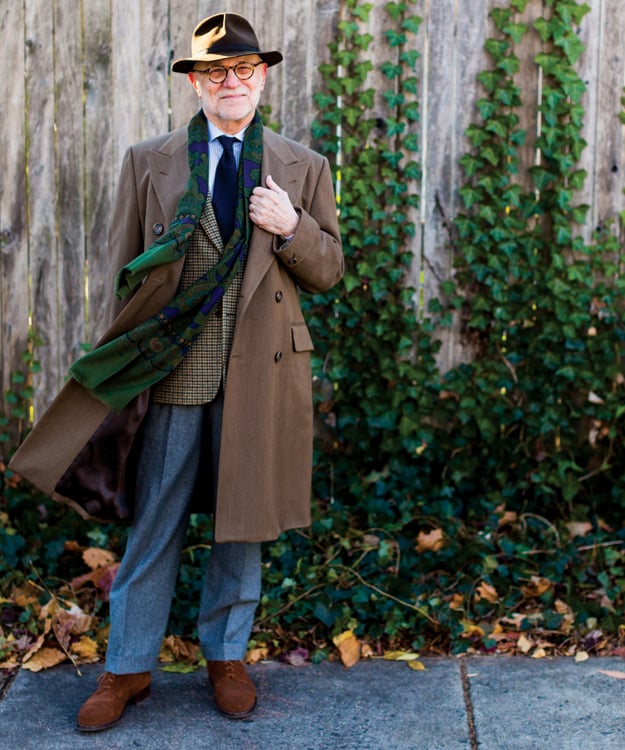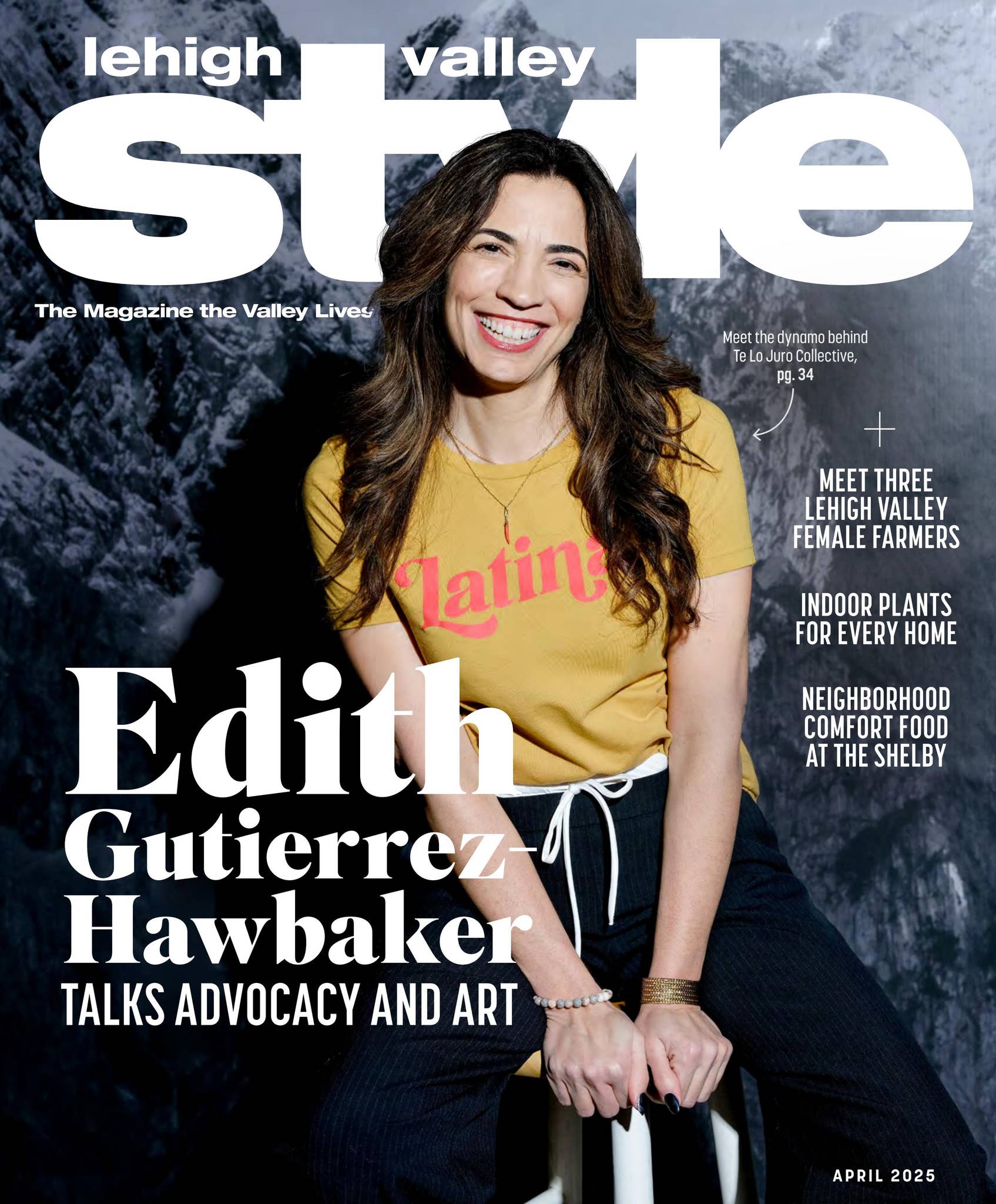
Fashion can say a lot about a person or the culture in which it lives.
Fashion does not just exist in a vacuum. It comes from somewhere and then goes someplace else.
What we choose to wear is an exercise in self-exploration and explanation. It says a little and a lot about who we are, all at the same time. It is often the first impression we make on the people we meet every day.
For G. Bruce Boyer, there is a fine line when it comes to writing about fashion and style. “You shouldn't take fashion too seriously,” he says. “It's not a cure for cancer. It's not going to solve world poverty or climate problems. At most, it's an economic business and it will make us feel better about ourselves.”
Boyer, a Bethlehem resident, considers himself the godfather of men's fashion writing. He has never tried to sell clothing nor has he told the public what to buy, but rather explains why certain people look better than others and what you can do to enhance your look.
Write and wrong
Boyer, who resides with his wife in one of Bethlehem's most historic neighborhoods, has written on the topic for more than 40 years. His byline was a staple in Town & Country magazine for 15 years, starting in 1972, and it has graced the pages of The New York Times, The New Yorker, Harper's Bazaar and other fashionable publications.
Boyer has authored four books, among them Eminently Suitable and Elegance: A Guide to Quality in Menswear, and co-authored four more. Of the latter, the list includes Gary Cooper: Enduring Style, on the late screen legend and written with Cooper's daughter, Maria Cooper Janis.
Boyer's love for fashion came at an early age. He credits his mother for being lax about what he would wear to school, which helped him make mistakes, try new things and eventually uncover his own style. Boyer learned that he had to find a way to compensate for his small build in order to ward off bullies and gain respect from his peers.
Film also had an influence on Boyer, whether it was the blue jean and motorcycle jacket style of James Dean or Fred Astaire in a tuxedo. He looked at men's fashion in a different way.
He says his personal style is American-Anglo with a dash of Italian for color, which he has retained since he was about 17 years old. His favorite piece of clothing is a hand-stitched, brown and green checked tweed jacket. It's soft, but durable, as he demonstrated by rolling it into a ball and tossing it on the floor. Made for him by Steven Hitchcock, a Savile Row master tailor in London, Boyer says the jacket will probably outlive him.
It's the style and the quality that Boyer is usually drawn to, a classic style that has suited him for years. And it is style that has garnered him some attention, as well. Boyer is featured in the book, I Am Dandy: The Return of the Elegant Gentleman, though he says he doesn't know why he's in the book.
“I'm not a dandy at all,” he says. “My dress is so conservative compared to some. You look at some of the guys in there, they are ready for Mardi Gras.”
The book, authored by Nathaniel Adams and photographed by Rose Callahan, features elegantly dressed men from all over the world. But Boyer says it's an honor being among the other featured men in the book.
Boyer admits he doesn't know much about women's fashion, save for the life of Coco Chanel and a few other designers. He says the terminology and the fabrics between clothing of the sexes are different.
“I wouldn't know how to think about women's clothing,” he says.

Understanding style
After seven years teaching English at Moravian Academy and Lehigh University, Boyer knew that he wasn't going to get a doctorate degree and it was time to move on to something else.
It was at that time the Duke of Windsor, also known as King Edward VIII, had passed away. As the most-photographed man of the first half of the 20th century, Boyer had a lot of material for an essay on the Duke's style.
“I had read everything he had written...I saw a lot of photos and news reels. There were a lot of stories [about him], but I thought that nobody understood this guy's style,” Boyer says.
Boyer was out of work at the time and didn't know what he was going to do, so he decided to write an essay on the Duke's style and send it to some publications because he thought he understood his approach to dressing. He chose three magazines to send it to—Town & Country, Esquire and Playboy—because someone told him they had paid well.
Town & Country said they would look at it and a week later Boyer received a phone call from the managing editor.
Boyer says that he was told the magazine had never really published men's fashion articles before, but they thought he had an interesting way of writing about the topic.
He ultimately wrote for the magazine for 15 years and was the men's fashion editor under Frank Zachary, a legend in the publishing world, Boyer says.
“He would take on people, photographers and writers...that no one had ever heard of,” Boyer says. “He would let you plow your own furrow. There was no Town & Country style. You did what you wanted.”
The early ‘70s brought Boyer a plethora of topics to write about as designers such as Ralph Lauren and Bill Blass came onto the scene. Blass was one of the designers Boyer eventually befriended and learned from.
“He was one of the most elegant men I have ever known, in both his appearance, he was very well tailored, and he had the most gracious sense about him. He talked like a Cole Porter song. He was a very elegant guy.”
Boyer used to hang around Blass' studio when he was working, learning a lot about design from the American Coty Award winner.
But the craftsmen were the ones Boyer learned from the most: the tailors, the shirtmakers and the shoemakers.
“These guys, they are so very good at what they do,” Boyer says.
It takes six to ten years to be able to get good enough to make a coat, Boyer says. It takes less time to become a surgeon.
“A really good shoemaker can tell you more about your feet than a doctor can. These people are very interesting,” Boyer says.
Boyer approaches the subject as it occurs in the world.
“I always thought that fashion was much more interesting, that it came from some place and went somewhere, and said something about us, both us personally and us as a culture and society and a time and a place,” Boyer says. “I try to hook fashion to something outside itself.”
He approached the subject as history, sociology, psychology and even used literature to decipher the topic.
“I think I'm the only fashion writer who will talk about tailoring and quote Chaucer or Byron,” he says.
Approaching fashion in that manner has made Boyer consider himself more of a popular historian of fashion, which has helped him in recent years as he has co-curated several fashion exhibits for the Fashion Institute of Technology.
The exhibits, “Elegance In An Age of Crisis: Fashions of the 1930s” and “Ivy Style,” became learning experiences for Boyer. Both exhibits
have accompanying books co-authored by Boyer, as well.
Though he won't call himself an expert on museums, he has learned what it takes to put an exhibit together, purveying articles of clothing from as far away as London, Naples and Paris.

His future in fashion
The writer says he has about two books left in him before he starts repeating himself in print. A third volume of his essays, entitled True Style, will be released in October 2015. In the next year he plans on publishing a book about fashions of the 1950s, which he hopes to have out in 2016, a passion project that he has always wanted to write.
While Boyer plans on retiring in the next few years, he feels the industry will be left in good hands. He follows up-and-coming writers by monitoring about 40 blogs a day. Boyer says the amount of bloggers creates healthy competition with the magazines.
“These young guys are just incredible. Some of them know more than I do already,” he says. “I'm very impressed. I'm fortunate to know a lot of them. It's very encouraging.”
Fashion and style for men doesn't have to be daunting, Boyer says. His best advice on building a wardrobe is to do it over years, investing in clothing that will last.
“Buy the best you can afford and keep it forever,” he says, giving examples of ties and shoes that he purchased 20 years ago and still wears. “Cheap clothing looks cheap even when it's new. But good clothing looks good even when it's old.”
But remember to keep it age-appropriate and consider if trends are right for you. Also, he says men shouldn't be afraid to try something new, especially when they are in the store.
“That's where you get an education,” he says. “Make mistakes, that's where you learn.” And for Boyer, taking on different projects has helped him learn what he is good at. Boyer has worn many hats over the years that include consulting and commentating for AMC's television documentary “Hollywood Fashion Machine,” to returning to Town & Country as a consulting and contributing editor and a consultant for others.
Over the years, others have asked him to try his hand at writing ad copy and scripts, and Boyer has come back to them with “I'll try, but I can't promise you anything.”
From those experiences, which have been wonderful for him, Boyer has learned that he is only good at a few things in life, working at his craft of being a writer.
“It's a craft. There's nothing magical about it. It's work,” he says.
Fashion can say a lot about a person or the culture in which it lives.
Fashion does not just exist in a vacuum. It comes from somewhere and then goes someplace else.
What we choose to wear is an exercise in self-exploration and explanation. It says a little and a lot about who we are, all at the same time. It is often the first impression we make on the people we meet every day.
For G. Bruce Boyer, there is a fine line when it comes to writing about fashion and style. “You shouldn't take fashion too seriously,” he says. “It's not a cure for cancer. It's not going to solve world poverty or climate problems. At most, it's an economic business and it will make us feel better about ourselves.”
Boyer, a Bethlehem resident, considers himself the godfather of men's fashion writing. He has never tried to sell clothing nor has he told the public what to buy, but rather explains why certain people look better than others and what you can do to enhance your look.
Write and wrong
Boyer, who resides with his wife in one of Bethlehem's most historic neighborhoods, has written on the topic for more than 40 years. His byline was a staple in Town & Country magazine for 15 years, starting in 1972, and it has graced the pages of The New York Times, The New Yorker, Harper's Bazaar and other fashionable publications.
Boyer has authored four books, among them Eminently Suitable and Elegance: A Guide to Quality in Menswear, and co-authored four more. Of the latter, the list includes Gary Cooper: Enduring Style, on the late screen legend and written with Cooper's daughter, Maria Cooper Janis.
Boyer's love for fashion came at an early age. He credits his mother for being lax about what he would wear to school, which helped him make mistakes, try new things and eventually uncover his own style. Boyer learned that he had to find a way to compensate for his small build in order to ward off bullies and gain respect from his peers.
Film also had an influence on Boyer, whether it was the blue jean and motorcycle jacket style of James Dean or Fred Astaire in a tuxedo. He looked at men's fashion in a different way.
He says his personal style is American-Anglo with a dash of Italian for color, which he has retained since he was about 17 years old. His favorite piece of clothing is a hand-stitched, brown and green checked tweed jacket. It's soft, but durable, as he demonstrated by rolling it into a ball and tossing it on the floor. Made for him by Steven Hitchcock, a Savile Row master tailor in London, Boyer says the jacket will probably outlive him.
It's the style and the quality that Boyer is usually drawn to, a classic style that has suited him for years. And it is style that has garnered him some attention, as well. Boyer is featured in the book, I Am Dandy: The Return of the Elegant Gentleman, though he says he doesn't know why he's in the book.
“I'm not a dandy at all,” he says. “My dress is so conservative compared to some. You look at some of the guys in there, they are ready for Mardi Gras.”
The book, authored by Nathaniel Adams and photographed by Rose Callahan, features elegantly dressed men from all over the world. But Boyer says it's an honor being among the other featured men in the book.
Boyer admits he doesn't know much about women's fashion, save for the life of Coco Chanel and a few other designers. He says the terminology and the fabrics between clothing of the sexes are different.
“I wouldn't know how to think about women's clothing,” he says.

Understanding style
After seven years teaching English at Moravian Academy and Lehigh University, Boyer knew that he wasn't going to get a doctorate degree and it was time to move on to something else.
It was at that time the Duke of Windsor, also known as King Edward VIII, had passed away. As the most-photographed man of the first half of the 20th century, Boyer had a lot of material for an essay on the Duke's style.
“I had read everything he had written...I saw a lot of photos and news reels. There were a lot of stories [about him], but I thought that nobody understood this guy's style,” Boyer says.
Boyer was out of work at the time and didn't know what he was going to do, so he decided to write an essay on the Duke's style and send it to some publications because he thought he understood his approach to dressing. He chose three magazines to send it to—Town & Country, Esquire and Playboy—because someone told him they had paid well.
Town & Country said they would look at it and a week later Boyer received a phone call from the managing editor.
Boyer says that he was told the magazine had never really published men's fashion articles before, but they thought he had an interesting way of writing about the topic.
He ultimately wrote for the magazine for 15 years and was the men's fashion editor under Frank Zachary, a legend in the publishing world, Boyer says.
“He would take on people, photographers and writers...that no one had ever heard of,” Boyer says. “He would let you plow your own furrow. There was no Town & Country style. You did what you wanted.”
The early ‘70s brought Boyer a plethora of topics to write about as designers such as Ralph Lauren and Bill Blass came onto the scene. Blass was one of the designers Boyer eventually befriended and learned from.
“He was one of the most elegant men I have ever known, in both his appearance, he was very well tailored, and he had the most gracious sense about him. He talked like a Cole Porter song. He was a very elegant guy.”
Boyer used to hang around Blass' studio when he was working, learning a lot about design from the American Coty Award winner.
But the craftsmen were the ones Boyer learned from the most: the tailors, the shirtmakers and the shoemakers.
“These guys, they are so very good at what they do,” Boyer says.
It takes six to ten years to be able to get good enough to make a coat, Boyer says. It takes less time to become a surgeon.
“A really good shoemaker can tell you more about your feet than a doctor can. These people are very interesting,” Boyer says.
Boyer approaches the subject as it occurs in the world.
“I always thought that fashion was much more interesting, that it came from some place and went somewhere, and said something about us, both us personally and us as a culture and society and a time and a place,” Boyer says. “I try to hook fashion to something outside itself.”
He approached the subject as history, sociology, psychology and even used literature to decipher the topic.
“I think I'm the only fashion writer who will talk about tailoring and quote Chaucer or Byron,” he says.
Approaching fashion in that manner has made Boyer consider himself more of a popular historian of fashion, which has helped him in recent years as he has co-curated several fashion exhibits for the Fashion Institute of Technology.
The exhibits, “Elegance In An Age of Crisis: Fashions of the 1930s” and “Ivy Style,” became learning experiences for Boyer. Both exhibits
have accompanying books co-authored by Boyer, as well.
Though he won't call himself an expert on museums, he has learned what it takes to put an exhibit together, purveying articles of clothing from as far away as London, Naples and Paris.

His future in fashion
The writer says he has about two books left in him before he starts repeating himself in print. A third volume of his essays, entitled True Style, will be released in October 2015. In the next year he plans on publishing a book about fashions of the 1950s, which he hopes to have out in 2016, a passion project that he has always wanted to write.
While Boyer plans on retiring in the next few years, he feels the industry will be left in good hands. He follows up-and-coming writers by monitoring about 40 blogs a day. Boyer says the amount of bloggers creates healthy competition with the magazines.
“These young guys are just incredible. Some of them know more than I do already,” he says. “I'm very impressed. I'm fortunate to know a lot of them. It's very encouraging.”
Fashion and style for men doesn't have to be daunting, Boyer says. His best advice on building a wardrobe is to do it over years, investing in clothing that will last.
“Buy the best you can afford and keep it forever,” he says, giving examples of ties and shoes that he purchased 20 years ago and still wears. “Cheap clothing looks cheap even when it's new. But good clothing looks good even when it's old.”
But remember to keep it age-appropriate and consider if trends are right for you. Also, he says men shouldn't be afraid to try something new, especially when they are in the store.
“That's where you get an education,” he says. “Make mistakes, that's where you learn.” And for Boyer, taking on different projects has helped him learn what he is good at. Boyer has worn many hats over the years that include consulting and commentating for AMC's television documentary “Hollywood Fashion Machine,” to returning to Town & Country as a consulting and contributing editor and a consultant for others.
Over the years, others have asked him to try his hand at writing ad copy and scripts, and Boyer has come back to them with “I'll try, but I can't promise you anything.”
From those experiences, which have been wonderful for him, Boyer has learned that he is only good at a few things in life, working at his craft of being a writer.
“It's a craft. There's nothing magical about it. It's work,” he says.





















